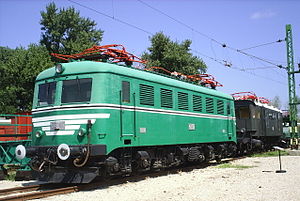MÁV series V55
| MÁV series V55 | |
|---|---|
|
BoCo
|
|
| Numbering: | V55.001-012 |
| Number: | 12 |
| Manufacturer: | Ganz & Cie , MAVAG , Budapest |
| Year of construction (s): | 1950-1957 |
| Retirement: | 1967 |
| Axis formula : | Bo'Co ' |
| Type : | Kandó |
| Gauge : | 1435 mm ( standard gauge ) |
| Length over buffers: | 14,600 mm |
| Height: | 4,650 mm |
| Width: | 3,000 mm |
| Trunnion Distance: | 7,350 mm |
| Bogie axle base: | 2,500 mm (Bo´) 3,500 mm (Co´) |
| Service mass: | 89.6 t |
| Friction mass: | 89.6 t |
| Wheel set mass : | 18 t |
| Top speed: | 125 km / h |
| Continuous output : | 2,354 kW |
| Starting tractive effort: | 240 kN |
| Hourly traction: | 160 kN |
| Driving wheel diameter: | 1,040 mm |
| Power system : | 15 kV 50 Hz |
| Power transmission: | with phase and period converter |
| Number of traction motors: | 5 |
| Drive: | Single axle drive type Tatzlager |
| Brake: | Handbrake air brake |
| Train brake: | KNORR |
| Particularities: | The last series-production locomotive, type Kandó , with a single-axle drive |
The MÁV series V55 was the last built according to the Kandó system and a single-axle drive series-produced electric locomotive of the Hungarian state railway MÁV .
history
The Kandó type locomotives , the V40 and V60 , produced from 1932 onwards , had proven themselves in operation. After several years there was increased wear and tear on the drive rods and coupling rods . Therefore, following suggestions from abroad, MÁV decided to develop single-axle electric locomotives.
The key points of the development work were that the new traction motors were smaller than the previous large traction motor. As a result, it was no longer possible to regulate the economical synchronous speeds of the motors using the appropriate number of poles. An attempt was made to change the appropriate frequency of the supply current for the traction motors. This was achieved by adding an additional period converter so that the main assemblies of the new locomotive were phase converters , period converters, and liquid starters.
A first attempt at this single-axle Kandó locomotive was made in 1939 with the test locomotive V44 , of which two examples were produced. In 1950 two locomotives of the V55 series with phase and period converters were delivered, and by 1954 another ten. The two deliveries differed in small details.
Since the MÁV's electricity system was converted to 25 kV 50 Hz in the 1960s, the locomotives were not allowed to operate for a longer period of time. The first were retired in the early 1960s, especially because there were problems with the construction of the vehicles . In 1967, the V55.004, the last machine of this type, was taken out of service. This locomotive is also the only surviving locomotive in this series.
technical features
The main assemblies of the locomotive are phase converters , period converters, and liquid starters . Phase and period converters supply the optimal current for the five traction motors for the synchronous speeds, the liquid starter regulates the constant acceleration of the locomotive to the set synchronous speeds of 25 km / h, 50 km / h, 75 km / h, 100 km / h, 125 km /H. As with the other Kandó locomotives, the engine driver could set the acceleration value individually.
The main frame of the locomotive consisted of longitudinal members connected with cross members. The locomotive body was welded from beams and plates. The weight of the locomotive was stored on a two-axle and a three-axle bogie . The different versions of the bogies were chosen for reasons of weight. These vehicles had not pivot, the rotation of the frame was made by the patented sliding supports the type Quite -Romain ensured. The pivot distance specified in the technical data is therefore the distance between the virtual pivot points. Overall, the frame and the locomotive body were supported by 16 pairs of helical springs coupled in parallel.
See also
literature
- Mihály Kubinszky (ed.): Hungarian locomotives and railcars . Akadémiai Kiadó, Budapest 1975, ISBN 963-05-0125-2 .
